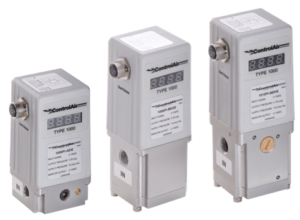ControlAir today announced the introduction of the new Type 1000P Electro-Pneumatic Pressure Regulator Series. The Electro-Pneumatic Series consists of the Type 1000P Precision Pressure Regulator, Type 1005P High Flow Pressure Regulator, and the Type 1010P Economic Pressure Regulator.

The Type 1000P/1005P/1010P Electro-Pneumatic Pressure Regulators are complete closed-loop servo systems consisting of two solenoid valves, an internal pressure sensor, and electronic controls. Based on analog signal, the pressure is controlled by two solenoid valves to maintain precise pressure: one valve functions as inlet control, the other as exhaust. The pressure output is measured by an internal or an external feedback pressure sensor that provides a feedback signal to the electronic controls.
A typical application for the Type 1000P Electro-Pneumatic Pressure Regulator Series is to control and monitor the pressure in pneumatic systems that drive automated machinery, robotic arms, and assembly line equipment. By maintaining the correct pressure, these regulators ensure consistent performance, accurate positioning, and reliable operation of industrial automation processes.
The Type 1000P Electro-Pneumatic Pressure Regulator Series is available in 1/8 in. or 1/4 in. NPT porting. Input signals are 4-20mA, 0-10V, or RS485 Modbus. Output ranges include 0-30 psig (0-2 bar), 0-60 psig (0-4 bar), and 0-120 psig (0-8 bar). Feedback monitor is internal or external, and monitor outputs are 4-20mA, 0-10V or 1-5V. A wide temperature range of 32º to 158º F (0º to 70º C). The response time is 0.8 seconds with accuracy at +0.1% full scale. Flow rates range from 8 scfh to 2,543 scfh.
ControlAir
controlair.com
Filed Under: Components Oil Coolers, Pneumatic Tips